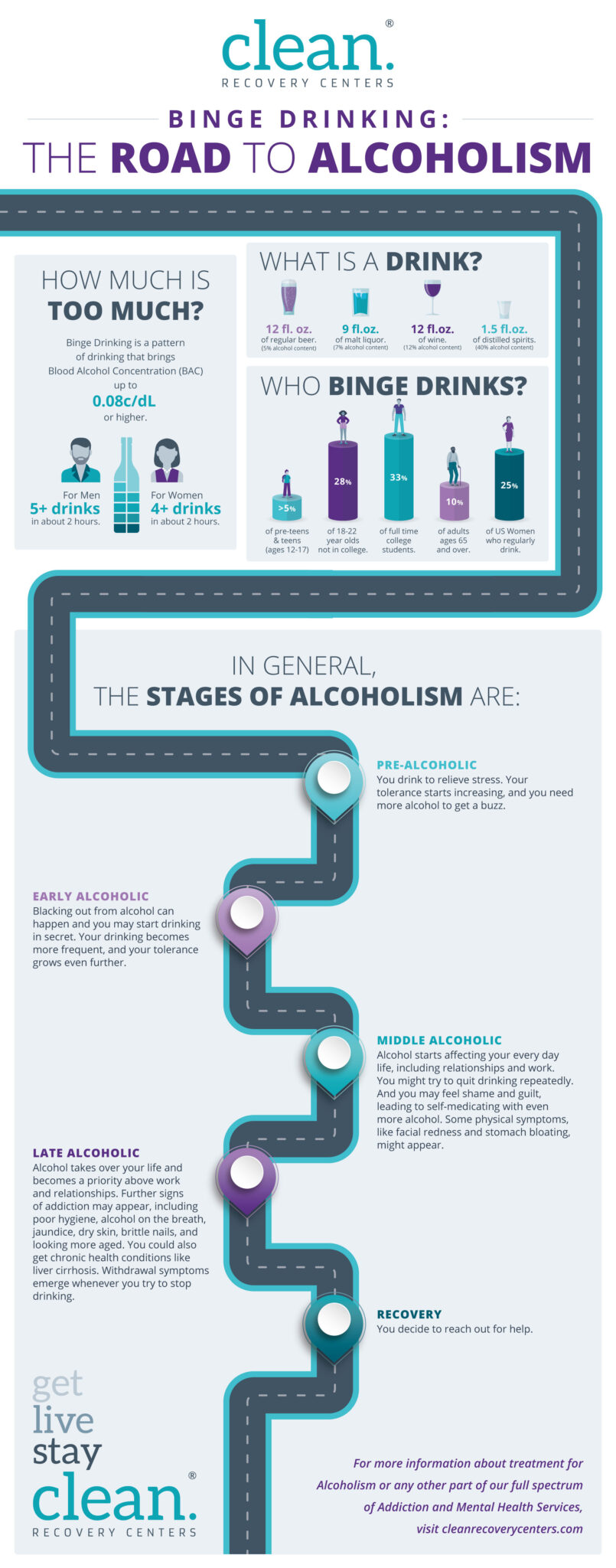Get Clean! Call us today!
1 (888) 330-2532
Alcohol Addiction
Binge Drinking Versus Alcoholism: Two Sides of the Same Coin
Alcoholism, binge drinking, and heavy drinking can all lead to significant consequences. However, each condition is unique from the one before it. Understanding how one AUD plays into the next can help you find and define the best methods for support.

What is alcoholism? It is an addiction, a mental and physical health crisis and condition. People diagnosed with the disorder are vulnerable to their urges and inability to turn away from the substance.
Alcoholism changes brain chemistry and body function. Even if a consumer or user wants to stop drinking alcohol, they may feel incapable. Their bodies react violently in the absence of the substance, and their brains create panic and anxiety. People with alcoholism need help and intervention. Still, there are various alcohol use disorders, and not all warrant the same level of intervention.
Alcoholism, binge drinking, and heavy drinking can all lead to significant consequences. However, each condition is unique from the one before it. Understanding how one AUD plays into the next can help you find and define the best methods for support.

What Is Considered Heavy Drinking?
When discussing what alcoholism is, it is easy to skew the information. Not every individual who drinks is an alcoholic. Not everyone who binge drinks occasionally is an alcoholic. Alcoholism is a specific condition, and it may not define even those who drink heavily and often.
Men who drink more than 14 drinks in a week or four drinks in a day meet heavy drinker minimums. Women need to consume more than seven drinks in a week or three drinks in a day for the same classification.
Despite the frequency of drinking, heavy drinkers do not meet the threshold for alcoholism or binge drinking. Alcoholism and binge drinking require patterned behaviors. Additionally, alcoholism is a mental and physical condition that makes alcohol avoidance unlikely or impossible without intervention and support. Heavy drinking is problematic, and it is the gateway to addiction, but it is not alcoholism.
Definition of Binge Drinking
Binge drinking is more than occasional heavy drinking. Binging is a pattern of overindulgence, and it occurs when someone routinely drinks enough to bring their blood alcohol content to 0.08%. The amount one must drink differs by individual and biological sex. Women tend to reach the specified BAC when consuming four or more drinks in about two hours. Men typically need to drink five or more in the same timeframe.
The consequences of binge drinking include blackouts and the risk of overdose. Additionally, drinking too much in one sitting reduces your inhibitions and leads to risky sexual behavior. Participating in frequent binge drinking can lead to health complications and several chronic diseases, such as:
- Liver damage
- Cancers (liver, colorectal, breast, esophageal, etc.)
- Heart disease
- Kidney disease
Definition of Alcoholic
What is an alcoholic?
If alcoholism is an addiction to alcohol, then the term alcoholic refers to the addict. Still, people grow too accustomed to such words, so it is vital to explain the term further. An alcoholic is better described as a patient with an alcohol use disorder. AUD is recognized as a condition that potentially cripples individual choice.
A person with AUD becomes dependent on alcohol, mentally and physically. They drink more than they can handle and cannot stop voluntarily. In many ways, alcohol, like so many other substances, alters a person’s brain and body. The thought of quitting the habit is unbearable in the most literal sense of the word.
Infographic
Binge Drinking: The Road to Alcoholism
How much is too much? Learn more about how Binge Drinking can lead to more severe alcohol abuse disorders.

Understanding Alcoholism
As a physical and mental health condition, alcoholism interferes with body functions and decision-making. However, the most astounding attribute of the substance is how it affects the body depending on the amount. Alcohol can provide euphoria in limited doses, but the feeling can quickly elevate to depression, confusion, and possibly death. These emotions tend to follow the stages of consumption.
As an infrequent consumer, an individual may sustain the casual euphoria that accompanies the occasional drink. However, addiction leaves people chasing the initial high. Unfortunately, frequent drinkers must consume more and more of the substance to experience euphoric feelings; hence, the trouble with using substances to fill an emotional void.
Alcohol is a corrosive substance. As a user drinks more of it, the drink damages the body. The dependency on alcohol means the body never has a chance to heal. The more someone drinks, the more their body and brain convince them they need it. The body shakes, tremors, and convulses in the absence of a drink, and the brain induces panic and stress until the user quenches its thirst.
What is alcoholism? It’s an addiction affecting the brain and body. The addiction cycle is vicious. Users need help to conquer it.
Alcohol Addiction
4 Stages of Alcoholism
When discussing alcoholism, one must take an aerial view of the disease. It would be best if you stepped outside of and above the basic symptoms to gain an overview of the condition. From an omniscient perspective, you can see the disease for what it is, a progressive disorder.
In 1946, a scientist, Morton Jellinek, authored a paper defining alcoholism’s progression. According to Jellinek, alcoholism follows a predictable trajectory or stages of decline. The evidence through Jellinek’s career culminated in the production of the Jellinek Curve. The curve is representative of the four stages of alcoholism:
- Pre-alcoholic stage
- Early-stage alcoholism
- Middle alcoholic phase
- End-stage alcoholism
The Pre-Alcoholic Stage
What is alcoholism when it isn’t alcoholism? In the pre-alcoholic stage, alcohol is not yet an issue. In the early stage of the addiction cycle, a user may find the effects of alcohol pleasant and reassuring. The drinks mimic natural processes that promote relaxation or action. The effect of alcohol to loosen inhibitions can become addictive and encouraging.
In the pre-alcoholic stage, the user can go down one of three paths. The first path occurs when the user stays in the pre-alcoholic stage; they drink socially but do not cross the line to dependence. The second path occurs when a user finds other, healthier ways to promote the same benefits of drinking; they stop drinking for good. The third and final path leads to the next stage; it occurs when the user drinks to bolster their mood or promote sleep. In the third path, people grow dependent on alcohol, progressing rapidly toward alcoholism. Signs of the pre-alcoholic stage include:
- Needing a drink to relax or unwind
- Relying on alcohol during social situations
- Using alcohol to cope with emotions
Early-Stage Alcoholism
Binge drinking is part of the prodromal phase in the stages of alcoholism; early-stage alcoholism is the standard title. Researchers suggest the phase is often a sign of experimentation gone wrong. Many people experiencing this phase of alcoholism will drink to the point of blacking out. One experience of blacking out or drinking too much is not an indication of alcoholism. However, when the experience becomes a pattern, it signals addiction and early-stage alcoholism.
It is challenging define alcoholism for an early-stage alcoholic because it can still fall in the realm of occasional drinking. People fitting into the category may not drink every day or week, but they tend to binge when they drink. Most people in the early-stage alcoholism category will describe their drinking as occasional and for relaxation or celebration. The common signs of early-stage alcoholism include:
- Frequent binge drinking
- Blacking out
- Routine promises to stop drinking
- Struggle to control the amount they drink
The Middle Alcoholic Phase
The middle alcoholic phase is when many people begin to notice problems. The person might experience problems at work, school, or home. Most often, family and friends will see changes in your behavior, and some of them may ask probing questions.
The problem with alcoholism as a disease is how it cultivates complicity in the patient. The affected individual will often lie to themselves, downplaying how much they drink or making excuses for out-of-character behavior.
Additionally, like other substances, alcohol provides diminishing returns over time. If an individual wants the same effects they experienced early in the use cycle, they will need more alcohol. As they chase the euphoria or other benefits of alcohol, they continue to increase the volume. Signs of someone in this stage of alcoholism include:
- Prioritizing drinking over other obligations
- Lying about behavior
- Progressive memory lapses
- Facial redness, shaking and sweating
The middle alcoholic phase is often the best point for intervention. People with the disorder might notice the problems of the illness, but it is still early enough in the progression of the condition to recover with minimal effects.
End-Stage Alcoholism
In which stage of alcoholism does the drinker face serious health problems? The end-stage. During end-stage alcoholism, people can no longer hide the long-term effects of abuse. Many people will face financial, professional, and physical problems. Drinking becomes an integral part of life at this stage, with most activities working toward supporting their addiction.
Additionally, the stress and anxiety of finances and personal relationships only push someone further into the abuse cycle. Paranoia frequently accompanies end-stage alcoholism.
Some people can maintain a semblance of a healthy, well-adjusted life. Known as functioning alcoholics, these individuals may continue to argue against claims of addiction. Still, functioning alcoholics will suffer health problems from drinking, including liver and kidney damage.
Failing to seek treatment for end-stage alcoholism will have disastrous effects on one’s health. The user will develop health problems, including alcohol-induced diseases like cancer or cirrhosis. When asked, “how does alcoholism kill you,” the answer is in various ways. Alcohol destroys vital organs and eventually leads to crippling and lethal diseases. Signs of end-stage alcoholism are obvious and include:
- Alcohol dependence
- Financial trouble
- Relationship trouble
- Career trouble
A person with end-stage alcoholism cannot operate without alcohol. You will often see them with alcoholic beverages. Affected individuals may also hide or stash alcohol in their homes and places of frequent visits.

Symptoms and Signs of Alcoholism
Learning about what is alcoholism is about educating yourself about the signs of the disease. A study by the National Institute on Alcohol Abuse and Alcoholism found that over 14 million U.S. adults have an alcohol use disorder. An AUD can progress to alcoholism. People with AUDs will eventually show alcoholism symptoms. The way to identify alcoholism is to review notable physiological, psychological, and biological changes. If you can identify these changes in yourself or others, it is possible to find help and support through the alcohol rehab at Clean Recovery Centers.
Reviewing Physiological Changes
What is alcoholism if not an accumulation of physical symptoms? Body changes point to the severity of the disorder and indicate the urgency of intervention.
Many people associate problems with balance and gait with intoxication. True, alcohol does impair the brain and results in coordination issues, but for an alcoholic, the problem is more pressing. The more a person indulges in alcohol, the more impaired the brain becomes. If alcohol becomes a habit, the brain may not recover or rebound from typical and temporary imbalances.
Additionally, as an observer, you may notice a loved one experiencing changes in weight and hygiene. Alcoholism can trigger weight loss or weight gain; it depends on the individual. One person can experience decreased appetite as they prioritize alcohol over nutrition. Another person may experience weight gain because alcohol may trigger cravings for high-fat foods.
Alcoholics may appear disheveled and become lax about hygiene. The addict’s brain focuses on the next drink rather than hygiene. The individual may not even notice the hygiene problem until someone points it out. The result of poor hygiene can lead to social problems that further isolate the individual, potentially compounding their “need” for a drink.
There are many other physical symptoms of alcoholism that family and friends should pay attention to. Some of the most common issues include:
- Frequent injuries
- Confusion
- Tremors or shakes
- Frequent vomiting or nausea
Understanding Psychological Symptoms
When pondering what alcoholism is, you need to consider the mental health side of the equation. In many instances, a person turns to alcohol to treat undiagnosed conditions or problems. For example, someone might drink to calm their nerves at social gatherings. The person may have a social anxiety disorder.
Unfortunately, a person using alcohol to treat other underlying issues only compounds their problems. Alcohol can contribute to the symptoms of other mental health conditions, making them worse. While alcohol may initially help take the edge off, the relief the substance offers is temporary. Some of the psychological side effects of alcohol use include:
- Anxiety and panic
- Mood swings
- Depression
Looking Into the Biological Symptoms of Alcoholism
Alcoholism is a destructive force on the body, particularly its defenses. The depressive nature of alcohol affects the system’s natural process, resulting in chaos, especially with long-term use. If an alcoholic does not seek treatment before the end-stage, they increase their risks of several coinciding diseases and problems, including:
- Immune system weakness
- Brain dysfunction
- Cancer
- Liver disease
- Heart disease
Alcohol Abuse vs Alcoholism
Alcohol abuse is not the same as alcoholism. Alcohol abuse is the overuse of alcohol to the point it becomes increasingly problematic. Heavy drinking and binge drinking are both attributes of alcohol abuse. Still, a person who abuses alcohol may still control their behavior. They may not experience withdrawal symptoms when they stop drinking.
When discussing what alcoholism is, you are talking about a more severe form of abuse. Alcoholism is the evolution from independent choice to complete dependence. When a person reaches a level of alcohol dependence, they experience severe withdrawal symptoms. Additionally, the pattern of abuse leads to changes in the brain and body. A person with alcoholism most likely cannot stop drinking on their own.
Help Is Available
Many people with alcoholism or other AUDs struggle with the idea of sobriety. They may know that getting sober is best, but the interest isn’t there. A lack of interest does not equate to a lack of trying. Some people fear the work of sobriety, which often requires psychological reflection. Many people do not want to face the causes of their addiction. Still, with support, sobriety is possible.
People also need to realize that sobriety is fragile. Many addicts get sober only to fall into their addiction days, weeks, months, or years later. The important thing is to use the tools available to develop a sound foundation of mental and physical health. With assistance and work, an alcoholic can become secure in their sobriety.
Cold Turkey Is Not the Answer
As tempting as the idea is, quitting cold turkey is often a mistake. Alcoholics who stop using on their own with immediacy can not only risk health complications, but they can also risk relapse. Quitting without putting in the psychological work means you are not resolving the reasons for drinking.
Many alcoholics who stop without help may experience some time without issue, but eventually, the unresolved problems creep back in, resulting in a relapse. Additionally, people who quit cold turkey are at risk of the kindling effect — worsening withdrawal symptoms from repeated relapses.
You do not have to answer the question, “what is alcoholism,” alone. Whether you are researching for a friend, loved one, or yourself, you can find the help you need. Call us today at 888-330-2532 to ask your questions and discuss possible treatment programs.
Sources:
- https://www.cdc.gov/alcohol/fact-sheets/binge-drinking.htm
- https://www.niaaa.nih.gov/publications/brochures-and-fact-sheets/binge-drinking
- https://www.mayoclinic.org/diseases-conditions/alcohol-use-disorder/symptoms-causes/syc-20369243
- https://scihi.org/morton-jellinek-alcoholism/
- https://www.webmd.com/mental-health/addiction/alcoholism-stages#1
- https://www.peacevalleyrecovery.com/blog/what-are-the-stages-of-alcoholism/
- https://www.alcohol.org/alcoholism-types/stages/
- https://www.health.harvard.edu/blog/heavy-drinkers-arent-necessarily-alcoholics-may-almost-alcoholics-201411217539
- https://www.niaaa.nih.gov/alcohol-health/overview-alcohol-consumption/moderate-binge-drinking

